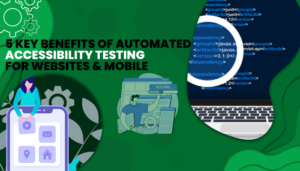
In today’s digital landscape, ensuring that your website or mobile app is accessible to all users is more important than ever. Not only does accessibility help meet legal requirements, but it also provides a better user experience for everyone. Automated accessibility testing is one of the most effective ways to quickly identify and fix accessibility issues in your digital products.
In this post, we’ll explore the key benefits of automated accessibility testing and why it should be an essential part of your development process.
1. Speed and Efficiency in Identifying Accessibility Issues
One of the most significant advantages of automated accessibility testing is the speed with which it identifies issues. Manual testing can be time-consuming, especially when it comes to large websites or mobile applications.
Automated tools, on the other hand, can scan a site or app in minutes, detecting a wide range of accessibility problems such as missing alt text, incorrect color contrast, or improper heading structure.
Automated tests allow developers to catch issues early in the development process, preventing delays and reducing the cost of fixing problems later on. By running automated checks at various stages of development, you ensure that accessibility is constantly monitored, helping to maintain a seamless, user-friendly experience across both web and mobile platforms.
Benefits for Your Workflow
- Faster detection of issues, saving time and effort.
- Immediate feedback after code changes or new content is added.
- Reduces the need for time-consuming manual testing.
2. Consistent Testing Across Platforms
With multiple devices, browsers, and operating systems in use today, ensuring accessibility across all platforms can be a challenge. Automated web accessibility testing provides a consistent approach to checking accessibility issues across different environments. Whether your website or app is being accessed on a desktop, smartphone, or tablet, automated tools can check for common accessibility problems that may vary across different devices.
By using automated testing tools, you can ensure that your site or app provides an equal experience to all users, regardless of how they access it. This consistency is critical for maintaining high standards of accessibility across web and mobile applications.
How This Helps
- Ensures accessibility across all platforms and devices.
- Guarantees a consistent user experience for both desktop and mobile users.
- Reduces the risk of platform-specific issues going unnoticed.
3. Cost-Effective and Scalable Solution
For many development teams, Accessibility testing automation is a cost-effective solution for ensuring that their products meet accessibility standards. The upfront investment in an automated testing tool may seem substantial, but the long-term savings are significant.
Automation reduces the need for extensive manual audits, which can be costly and resource-intensive, particularly for large or complex websites and mobile applications.
Moreover, automated accessibility testing scales easily. As your project grows or changes, you can simply run new tests to ensure that no accessibility issues have been introduced. This scalability is particularly valuable for ongoing maintenance, as websites and apps often undergo frequent updates.
Key Cost-Saving Benefits
- Reduces the need for expensive manual audits.
- Scales with the size of your project or organization.
- Lowers the risk of costly accessibility lawsuits or rework.
4. Improved User Experience for All Audiences
When you prioritize Automated accessibility checks, you’re not just ensuring compliance—you’re also enhancing the user experience for a broad audience. Accessibility isn’t only important for people with disabilities; it also improves the overall user experience for everyone.
For instance, ensuring that your site is navigable by keyboard and providing clear, descriptive alt text for images helps users who may be distracted or multitasking. Features like high-contrast text and screen reader compatibility also benefit users with temporary impairments, such as those experiencing eye strain from prolonged screen use.
By integrating accessibility testing tool into your workflow, you can identify and resolve issues that may hinder any user’s ability to navigate your site or app smoothly.
Enhanced User Experience
- Makes websites and apps easier to use for all users.
- Improves navigation for individuals with disabilities, such as those using screen readers.
- Benefits users with temporary impairments, like vision fatigue.
5. Helps Meet Legal and Regulatory Compliance
Accessibility isn’t just about creating a better user experience; it’s also about staying compliant with legal and regulatory requirements. Laws such as the Americans with Disabilities Act (ADA) in the U.S., the Equality Act in the U.K., and the Web Content Accessibility Guidelines (WCAG) globally, require that websites and mobile applications be accessible to people with disabilities.
Failing to meet these accessibility standards can lead to lawsuits, financial penalties, and damage to your reputation. Automated testing for accessibility issues helps ensure that your website or app complies with these regulations by identifying and addressing potential violations before they become problems.
By automating accessibility checks, you make it easier to stay compliant throughout your development process. Regular testing and quick remediation of accessibility issues also demonstrate a commitment to accessibility, which is vital for your brand image and user trust.
Compliance Benefits
- Ensures your website or app meets legal accessibility standards.
- Helps prevent lawsuits and financial penalties.
- Demonstrates a commitment to inclusivity and equal access.
How Automated Accessibility Testing Works
Now that we’ve explored the benefits, let’s take a closer look at how Automated testing for accessibility issues actually works. These tools typically analyze websites or mobile applications based on established guidelines like WCAG or Section 508 compliance.
The Process
- Initial Scan: The testing tool scans your website or app for common accessibility issues such as missing alt text, poor color contrast, or issues with HTML structure.
- Generate Reports: After the scan, the tool generates a detailed report outlining all identified issues, categorized by severity. This report may also provide code-level suggestions for fixing the problems.
- Integration with CI/CD: To ensure continuous accessibility testing, automated tools can be integrated into your Continuous Integration/Continuous Delivery (CI/CD) pipeline, automatically running tests whenever new code is added or updated.
- Ongoing Monitoring: Automated tools can be scheduled to run periodic checks, keeping accessibility on track even as your website or app evolves.
Popular Tools for Automated Accessibility Testing
- Axe: A popular open-source accessibility testing engine that integrates with various CI/CD tools.
- Lighthouse: Google’s open-source tool that provides automated audits for web applications, including accessibility.
- Wave: A browser extension that provides visual feedback about the accessibility of web content.
To Wrap Up
As web and mobile applications become increasingly complex, ensuring they are accessible to all users is non-negotiable. Automated accessibility testing provides a fast, consistent, cost-effective, and scalable solution for identifying and fixing accessibility issues.
By automating this process, businesses can improve user experience, reduce legal risks, and enhance compliance—all while maintaining a high standard of accessibility. Incorporating automated accessibility testing into your development workflow is not only the right thing to do but also a smart business move that ensures your digital products are inclusive, compliant, and user-friendly.
By prioritizing accessibility from the start and utilizing automated testing tools, you can build websites and mobile apps that everyone can use—regardless of their abilities—ultimately creating a better digital experience for all.
If you’re looking for powerful Automated Accessibility Testing tools, consider Testevolve. It offers robust accessibility testing features that seamlessly integrate with your CI/CD pipeline, ensuring your web and mobile apps remain accessible, user-friendly, and compliant with industry standards.
For Read More Articles You Can Explore this Website – https://guestpostsubmission.com/




